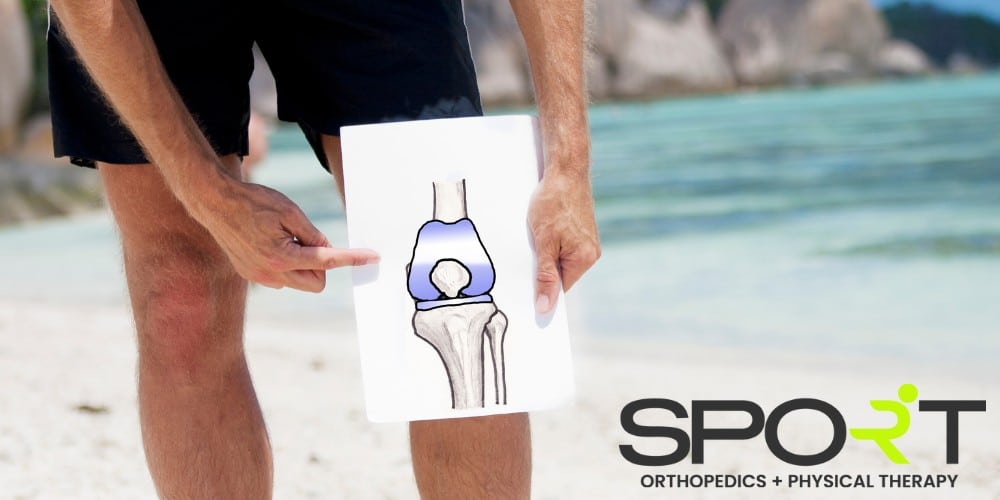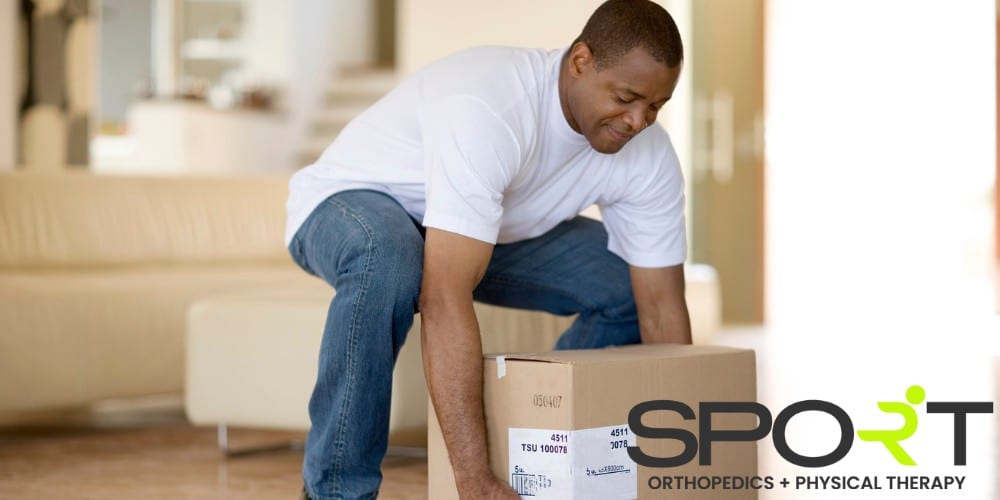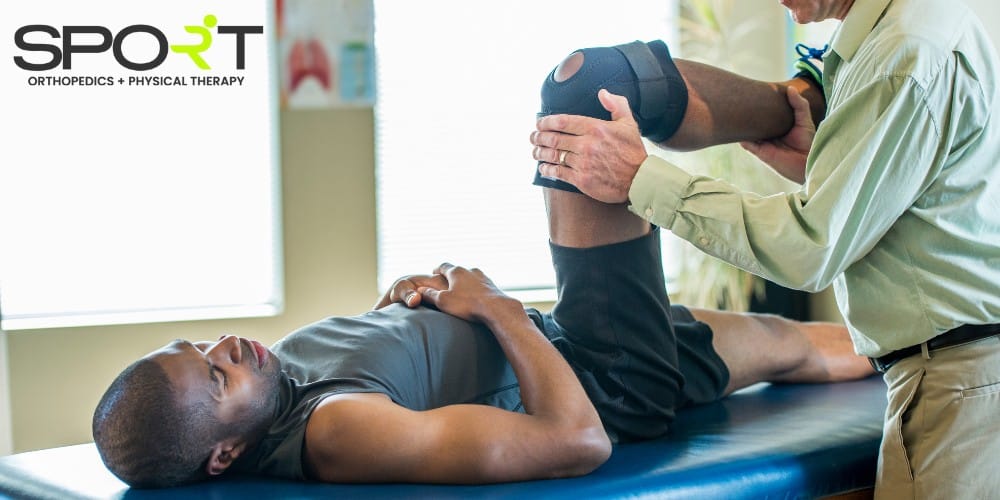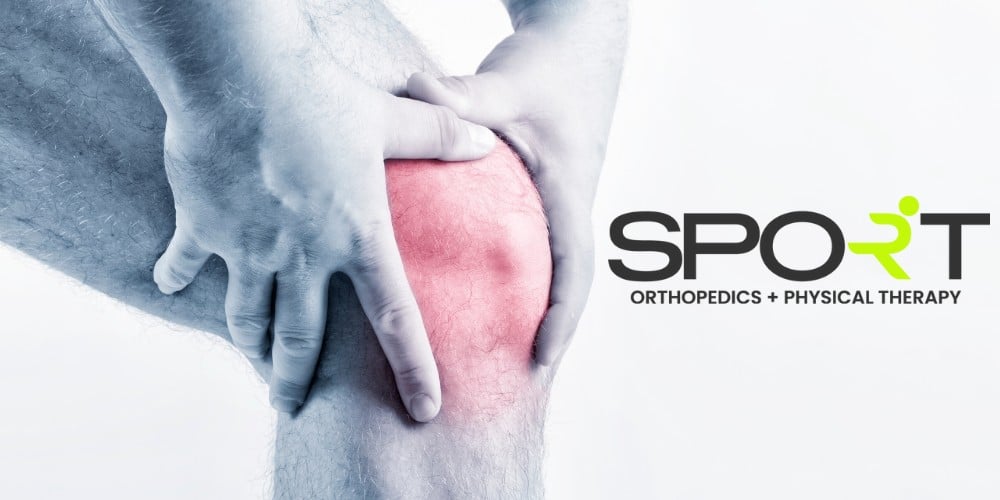
Knee replacement surgery is one of the more common forms of orthopedic surgery. As the knee joint degrades with time or suffers an injury, its functionality and stability may decrease. When this happens, patients can experience pain, knee clicking, knee arthritis, and many other complications. In some cases, it may be time for a whole new knee. This can be achieved through a total knee replacement, which involves replacing the original knee joints with implants. This blog aims to outline what not to do after knee replacement surgery, whether you had traditional knee replacement surgery or robotic knee replacement surgery.
At SPORT Orthopedics + Physical Therapy, our sports medicine professionals have extensive experience with both partial and total knee arthroplasty procedures. An orthopedic surgeon with our team can evaluate the source of your pain, perform a total knee replacement, restore knee function, and guide you through the healing process. To schedule an appointment with us for a new knee replacement, please call our office at 469-200-2832 today.

First, we’ll briefly go over how for the months after surgery. The recovery process for a knee replacement requires careful planning as well as strict adherence to your surgeon’s instructions. Before undergoing your surgery, be sure to complete the following preparations.
As with any surgery, knee arthroplasty has certain risks that doctors advise their patients of beforehand. The risks associated with knee surgery are as follows.

The recommendations from your surgeon and your physical therapist were explained for very important reasons. Chief among these is the fact that taking care of your knee/s during the recovery process will help with your recovery. Sports medicine professionals have the knowledge that it takes to recommend the best steps to a full recovery. Below, we’ll begin by explaining what NOT to do after knee replacement surgery.
Even if you don’t have to go into the doctor’s office for your physical therapy, you should still stick to the knee exercises that your physical therapist recommends. Only do exercises that your physical therapist clears when recovering from surgery. Don’t skip out on the exercises that will help speed along your recovery.
Most patients require some form of an assistive device, whether it’s a brace or a walker. No matter what, do not stop using this device too early. Your doctor will let you know when your knee is healed enough to bear weight. Too much stress or too much weight too early can reinjure your knee joint.
Part of preparing your home for the recovery period involves preparing places to sit. Sitting in low or soft chairs, rocking chairs, and low car seats can put stress on your knee when you get up. Avoid low seats and soft seat material. Instead, opt for a higher, firm chair that is easy to get in and out of.

Refrain from lifting weights or heavy objects. This means no weight training while you recover. If you like to lift weights or exercise regularly, ask your physical therapist for alternatives in the meantime. Also, the restriction on heavy objects includes grocery bags. Have someone help you bring in groceries if you have several heavy bags.
Don’t wear shoes or footwear that give you unstable footing. This means you can’t wear flip-flops, soft socks, high heels, platforms, and any other unstable footwear. If you don’t wear shoes indoors, consider wearing grip socks to avoid slipping on smooth flooring.
Do not run or jog while your knee heals. Both of these activities put tremendous stress on the knees, which is the last thing you want after serious surgery. This is especially true for running or jogging on uneven ground. You also should not play contact sports, high-impact sports, try to downhill ski, or try playing tennis. Avoid sports in general until your knees fully heal.

There are several exercises that your physical therapist will recommend for you during the recovery process. These exercises should be performed every day, as they will help gently strengthen your joint without the risk of injury. However, other forms of exercise should be avoided while you recover. Below, we list certain exercises to avoid after a knee replacement.
Any activity, sport, or exercise that has a high fall risk should be avoided. Knee replacements lead to a heightened fall risk already, so keeping your risk low is very important. When you shower, we recommend keeping the bathroom floor dry at all times, placing grip mats where you’ll walk, and considering using a shower chair.
Any activities in which your knee will bear weight should be avoided. Surgeons ask many patients to get out of bed to bear weight on their joints as soon as possible after surgery. However, this only applies to your own body weight. Avoid putting extra weight on your lower leg joints.
Again, high-impact sports are a no-go after surgery. You should also avoid any sport or activity that requires quick changes in direction. Examples of activities to avoid include football, soccer, hockey, basketball, rugby, skiing, and gymnastics. We recommend swimming, riding a bicycle, or playing golf instead.
Try not to kneel until your knee has completely healed. Also, refrain from sitting for too long. Keeping your knee in the same position for too long can cause a blood clot. Long car rides should be avoided if at all possible. If not, you should make frequent stops to stretch your legs.

After your surgery, your physical therapist will likely recommend two very beneficial exercises for your recovery: knee straightening and knee bending. Our sports medicine team will show you how to properly perform these exercises on your own before you ever leave for home.
Lie flat on your back with your knees pointed straight ahead. Place a small rolled-up towel under your heel. Gently try to straighten your knee as much as possible. When you fully straighten it, keep the knee straight for 5 to 10 seconds. Return to the starting position and repeat.
Start by lying down in bed. Slide the bottom of your foot back along the bed toward your pelvis. When you can’t bend your knee further, hold this position for 5 to 10 seconds. Straighten the knee, then repeat this process.

Unfortunately, this question is not easy to answer. Each patient’s case is unique, which means their healing process is also unique. Even without any complications, some patients still feel pain and experience swelling for up to a year after the surgery. However, the intensity of the pain should fade with time. If you still feel debilitating pain after a year, there may be a deeper problem. Take your pain medicines as prescribed, which means only the amount that the container states.
Recovery times also vary greatly depending on the patient, as well as the complexity of the procedure. Most patients can get back to living their normal lives in as little as two to three months. However, you should still follow your doctor’s recommendations. They can keep you moving in the right direction for your recovery.
Any surgery has its potential risks and complications. One of the most common problems reported after knee surgery is stiffness in the joint. This stiffness can cause difficulty in completing everyday tasks. The best way to avoid knee stiffness is to attend physical therapy sessions and work on exercises at home. This can help prevent stiffness from occurring in the first place.

At SPORT Orthopedics + Physical Therapy, our knee specialists are here for you during your time of need. We can help you find a solution to reduce pain, increase your range of motion, and get back to leading your pain-free life. After developing a customized treatment plan for you, we’ll help you stick to it and keep you pointing straight ahead in the right direction. To schedule an appointment with the best Dallas orthopedic surgeon, please call our office at 469-200-2832 today.







*We accept most all insurance plans, if you do not see your plan listed above or have any questions, please contact our office.

SPORT Orthopedics + Physical
Therapy – Dallas, TX
Services:
• Clinic • Orthopedic • Urgent Care
• Physical Therapy
18152 Preston Road
Suite I-2
Dallas, TX 75252
Phone: (469) 200-2832
Fax: (469) 269-1074
SPORT Orthopedics + Physical Therapy – Frisco, TX
Services:
• Clinic • Orthopedic • Urgent Care
• Physical Therapy
9255 Dallas Parkway
Suite I20
Frisco, TX 75033
Phone: (469) 200-2832
Fax: (469) 269-1074
SPORT Orthopedics + Physical
Therapy – Wylie, TX
Services:
• Clinic • Orthopedic • Urgent Care
• Physical Therapy
3400 FM 544
Suite 650
Wylie, TX 75098
Phone: (469) 200-2832
Fax: (469) 269-1074
SPORT Physical
Therapy – Prosper, TX
Services:
• Physical Therapy
790 N Preston Rd
Suite 60
Prosper, TX 75078
Phone: (469) 850-0201
Fax: (469) 269-1074
SPORT Orthopedics – Mesquite, TX
Services:
• Clinic
• Orthopedic
• Urgent Care
1102 North Galloway Ave
Mesquite, TX 75149
Phone: (469) 200-2832
Fax: (469) 269-1074